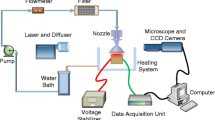Abstract
Several important parameters, such as liquid mass flux, droplet size distribution, droplet velocity, and heating target conditions (roughness and surface temperature) are involved in the industrial spray cooling heat transfer process. In this study, we investigated the effect of liquid mass flux, heating target roughness, and the droplet size on the droplet wall direct contact heat transfer in spray cooling phenomena. Three different conditions of surface roughness were investigated. The measurement of test surface temperature was performed using a non-intrusive method, i. e., using an infrared thermometer. The droplet size distribution of water spray was measured with Malvern 2600. The results indicated that the most influential parameters were the liquid mass flux and the surface roughness. The droplet size and the velocity played a less important role in the direct contact heat transfer because the interactions between droplets were very strong in a dense spray. The smooth surface showed the highest heat transfer among the surfaces tested. At high air pressure ([7] kPa), however, the degree of roughness did not affect much the heat transfer rate.
Similar content being viewed by others
References
Bolle, L. and Moureau, J. C., 1982, Spray Cooling of Hot Surfaces,Multiphase Science and Technology, Hemisphere Publishing Corp., Washington, D. C., pp. 1–97.
Choi, K. J. and Yao, S. C., 1987, “Mechanism of Film Boiling Heat Transfer of Normally Impacting Spray,”International Journal of Heat and Mass Transfer, Vol. 30, pp. 311–318.
Deb, S. and Yao, S. C. 1989, “Analysis on Film Boiling Heat Transfer of Impacting sprays,”International Journal of Heat and Mass Transfer, Vol. 11, pp. 2099–2112.
Delcorio, B., and Choi, K. J., 1991. “Analysis of Direct Liquid-Solid Contact Heat Transfer in Monodispersed Spray Cooling,”Journal of Thermophysics and Heat Transfer, Vol. 5, No. 4, pp. 613–620.
Ghodbane, M. and Holman J. P., 1991. “Experimental Study of Spray Cooling with Freon-113,”International Journal of Heat and Mass Transfer, Vol. 34, No. 4/5, pp. 1163–1174.
Hall, P. C., 1975, “The Cooling of Hot Surfaces by Water Sprays,” Central Electricity Generating Board, RD/B/N 3361.
Mizikar, E., 1970, “Spray Cooling Investigation for Continuous Casting of Billets and Boolms.”Iron Steel Engineering, pp. 53–70.
Ohkubo, H. and Nishio, S., 1989, “Study on Accurate Prediction of Mist Cooling.”Heat transfer Japanese Research, pp. 43–50.
Pais, M. R., Chow, L. C., and Mahefkey, E. T., 1992, “Surface Roughness and its Effect on the Heat Transfer Mechanism in Spray Cooling,”ASME Journal of Heat Transfer, Vol. 114, pp. 211–219.
Yao, S. C. and Choi, K. J., 1987, “Heat Transfer Experiments of Monodispersed Vertically Impacted Sprays,”International Journal of Multiphase Flow, Vol. 13, No. 5, pp. 639–648.
Author information
Authors and Affiliations
Rights and permissions
About this article
Cite this article
Kang, BS., Choi, KJ. Cooling of a heated surface with an impinging water spray. KSME International Journal 12, 734–740 (1998). https://doi.org/10.1007/BF02945735
Received:
Issue Date:
DOI: https://doi.org/10.1007/BF02945735




